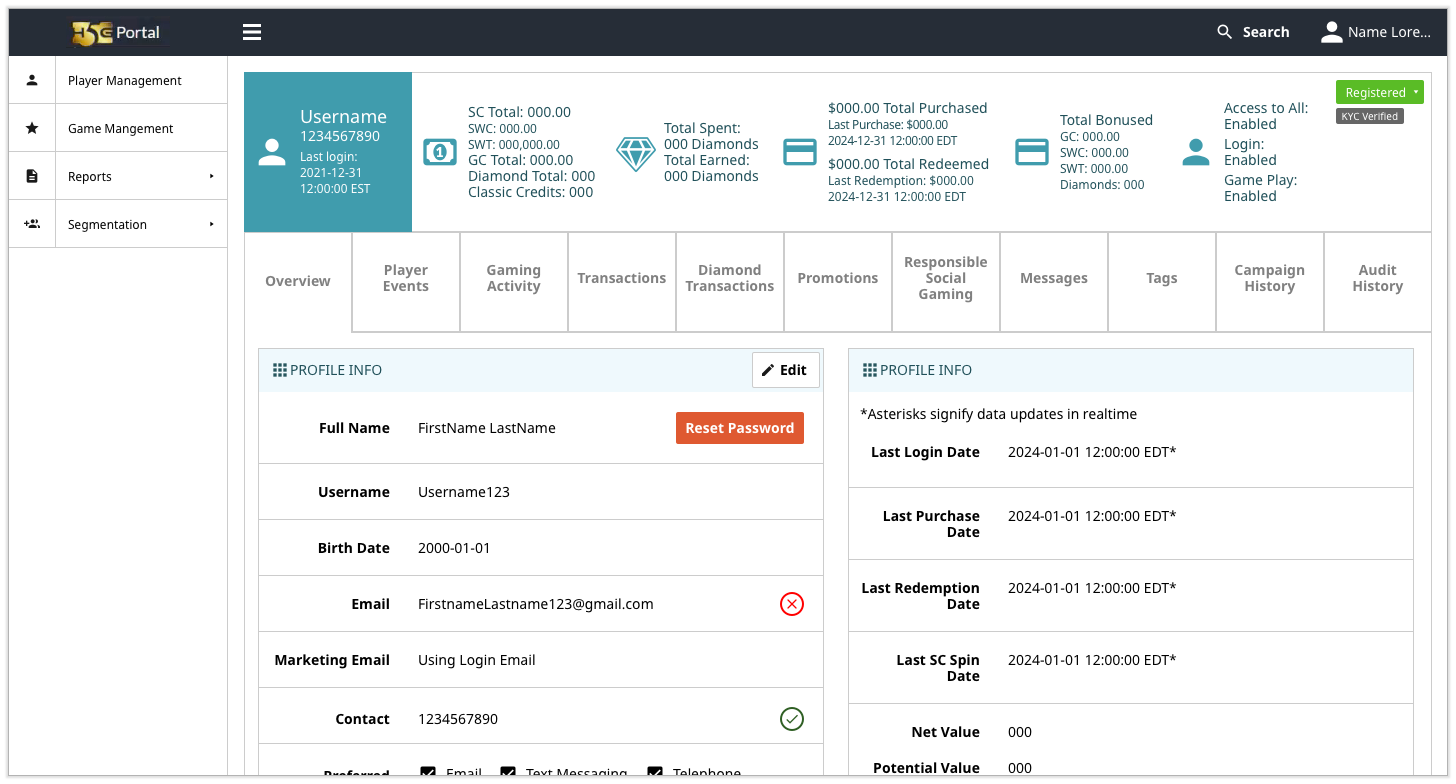Product Design | User research | Feature Prioritization
Project Length: 8 Months
The Problem
At the beginning of 2024 I was tasked with reviewing the internal Player Account Management (PAM) Tool at High 5 Games to provide improvements for the customer support agents who use it on a daily basis. With live chat slated for release later that year there was concern that the tool was causing issues and reducing the amount of support tickets our agents could handle in a day. Improving the PAM Tool was a must if we wanted our agents to keep up with demand.
The Overview screen for an account on the Player Account Management (PAM) Tool.
The TEAM
I was the sole designer on this project working with a Project Manger and collaborating with managers from our two customer support teams: Customer Services and Fraud & Payments.
Goals & Challenges
To get things started we began with a kickoff and settled on some initial goals for this project:
Improve Bandwidth: Reduce time spent per customer support ticket to provide agents the necessary bandwidth for the projected influx of tickets from live chat.
Gather Feedback: Track pain points, issues, and requests from Customer Support and Fraud & Payments teams.
Streamline Workflows: Keep workflows within our internal ecosystem by minimizing the need for workarounds via third party tools.
With our goals set I began gathering requirements and interviewing stakeholders. I quickly learned that the PAM Tool was an ad hoc build that evolved without much direction. Relevant stakeholders and devs were scattered across departments, requiring more cross-functional collaboration and legwork than usual.
The Research
User interviews were critical for this project as I was unfamiliar with the PAM Tool and its features. I interviewed 11 people in total making sure that there was equal representation from both Customer Services and Fraud & Payments.
Org chart of the individuals interviewed.
While there was some overlap between the teams their priorities differed. Customer Services dealt with player communication and troubleshooting. Fraud & Payments focused more on refunds and catching fraudulent behavior. Both of which had their own feedback and issues that required consideration when designing improvements.
Findings & Solutions
The amount of feedback was impressive, after analyzing the interviews and documenting the findings we focused on prioritizing solutions for issues that were easy to implement but had a large impact. The goal was to address agent needs in a timely manner and produce noticeable wins early on to maintain stakeholder buy-in for this project.
Search Result Reset
Results reset each time a player profile was opened. For tickets that required multiple accounts to be reviewed side by side this reset routinely got in the way.
Solution: Right click was disabled on this screen. Enabling it allowed agents to open profiles in a new tab from search results.
Time Spent per Ticket: 25% Less
Clicks per Task: 40% Less
Unclear Account Tags
Due to a limited and vague selection of account status tags, agents were forced to dig through player accounts or access third party tools for clarification.
Solution: Add additional statuses to help agents identify important information at a glance.
Time Spent per Ticket: 28% Less
Reduced need to access third party tools
Scrolling Table Headers
Agents were having difficulty reading table data due to table headers moving out of frame when scrolling. This also made it difficult to share screenshots of data when resolving tickets.
Solution: Pin table headers so they are visible while scrolling.
Time Spent per Ticket: 8% Less
The first set of updates were met with widespread approval from both teams. With these early successes in place, focus was shifted to a more involved but necessary improvement.
Audit History
The PAM Tool had no clear means of logging changes made to a user's account. To make due, agents posted comments in a notes section describing the changes made. Unfortunately there was no way to edit comments after submitting, leading to important data being buried by excessively long comment threads.
When addressing this issue with upper management it was revealed that this was intentional. The original purpose of the PAM Tool was a source of truth, allowing editing might increase the risk of critical user data being tampered with.
With that in mind, the solution was straightforward: develop an automated changelog. Agents save time by not having to log changes and the data remains securely tied to the back end.
Annotated wireframes for the proposed Audit History screen. After a few rounds of iteration this feature was slated for release at a later phase.
OUtcome
With a workflow and roadmap in place I continued to work through the list of updates over the course of the next few months. Follow up interviews were scheduled on a regular basis to track the success of our changes and note further issues or requests. Additional features for the PAM Tool were developed throughout the year, though I unfortunately ended my time with High 5 Games before seeing many of them go live.
I succeeded in improving the tool for our agents however there was of course more to do. Had I stayed on I would have continued to work up the priority list to tackle the more resource heavy tasks. Although I won’t be able to see these improvements in I’m proud of what I accomplished and the work I’ve set in motion.







